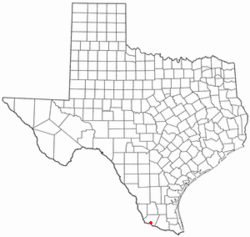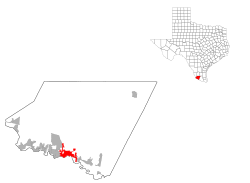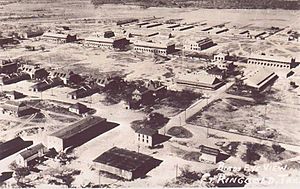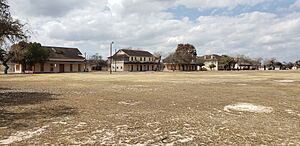Rio Grande City, Texas facts for kids
Quick facts for kids
Rio Grande City, Texas
|
||
|---|---|---|
| City of Rio Grande City | ||
|
Santa Cruz at Rio Grande City, Texas, Plaque describing the history of Rio Grande City, Texas, Plaque of the Old Rio Grande City Cemetery
|
||
|
||
| Nickname(s):
"RGC"
|
||

Location of Rio Grande City in the U.S. state of Texas
|
||
 |
||
| Country | United States | |
| State | Texas | |
| County | Starr | |
| Settled | 1846 | |
| Founded | 1848 | |
| Incorporated | May 1993 | |
| Area | ||
| • Total | 11.35 sq mi (29.40 km2) | |
| • Land | 11.35 sq mi (29.40 km2) | |
| • Water | 0.00 sq mi (0.00 km2) | |
| Elevation | 174 ft (53 m) | |
| Population
(2020)
|
||
| • Total | 15,317 | |
| • Density | 1,349.5/sq mi (520.99/km2) | |
| Time zone | UTC-6 (Central (CST)) | |
| • Summer (DST) | UTC-5 (CDT) | |
| ZIP code |
78582
|
|
| Area code(s) | 956 | |
| FIPS code | 48-62168 | |
| GNIS feature ID | 1388199 | |
| Website | www.cityofrgc.com | |
Rio Grande City, often called "RGC," is a city in Texas, United States. It's the main town of Starr County. In 2020, about 15,317 people lived there. The city is located in the Rio Grande Valley, about 41 miles (66 km) west of McAllen. You can even cross a bridge from Rio Grande City to Camargo, Tamaulipas in Mexico! This city once held the record for the highest temperature in the U.S. in March, reaching 108°F (42°C).
Contents
A Look Back in Time
The area where Rio Grande City now stands was first settled by Spanish colonists. They built a town called Camargo on the south side of the Rio Grande. After the Mexican-American War, when the United States took over this land, more people started settling on the northern bank.
In 1846, the northern bank began to grow. The US Army used it as a supply base during the Mexican-American War. This spot was important because it was the farthest point up the Rio Grande that steamboats could easily reach.
During the war, a U.S. soldier named Henry Clay Davis married Hilaria de la Garza Falcon. She owned the land on the north side of the river. After the war, Davis decided to create a formal city on this land. He divided it into plots to sell.
At first, the area was called Rancho Davis. Later, Davis and others changed the name to Rio Grande City. They hoped this new name would attract more settlers and investors from other parts of the U.S. From its start in 1848 until 1883, Rio Grande City was a major trading center between Texas and Mexico. It was also known as part of the "Wild West" because of its exciting history.
Some famous early residents lived here. These included Joshua H. Bean, who was the first mayor of San Diego, California. Orlando C. Phelps was one of the few survivors of the Mier Expedition. Edwin R. Rainwater was a hero of the Texas Revolution. Edward R. Hord was an important leader in South Texas. John L. Haynes was a politician and writer who supported Mexican-American rights.
Rio Grande City has kept some of its old buildings. It even has a special historic district. One of these old buildings is the La Borde House, built in 1899. It was designed in Paris for a French merchant. The house was later updated in the 1980s. Today, it is a hotel with a parlor, patio, and restaurant.
In May 1993, Rio Grande City officially became an incorporated city.
Fort Ringgold: A Historic Military Post
Ringgold Barracks was a military fort built in 1848. It was named after Major Ringgold, a soldier who was hurt in the Battle of Palo Alto. Soldiers were sometimes moved away from the fort, but they often came back. For example, they returned in 1859 during the Cortina War.
The fort was left empty at the start of the Civil War in 1861. But U.S. forces came back in 1865. Fort Ringgold was active until 1944. Then, the land was sold to the Rio Grande City public school system. Many different military groups were stationed here, including the famous Buffalo Soldiers.
Today, the original parade ground is still there. Several of the old fort buildings are now used by the schools. These include the guard houses, barracks, and officers' quarters. The Rio Grande City United States Army Reserve Center is the only military group still in the Fort Ringgold area.
City Location and Size
Rio Grande City is located at 26°22′50″N 98°49′6″W / 26.38056°N 98.81833°W. The city covers about 11.4 square miles (30.0 km2) of land.
Learning and Schools
Students in Rio Grande City are served by the Rio Grande City Grulla Independent School District.
There is also a private school called Immaculate Conception School. It was founded in 1884. This Catholic school teaches students from Pre-K through eighth grade. About 250 students attend each year.
Well-Known People
- Shannon Dingle: A Christian writer and activist who taught special education writing at Ringgold Middle School.
- Ricardo Sanchez: A Lieutenant General who commanded U.S. forces in Iraq before retiring from the United States Army.
Population Facts
| Historical population | |||
|---|---|---|---|
| Census | Pop. | %± | |
| 1950 | 3,992 | — | |
| 1960 | 5,835 | 46.2% | |
| 1970 | 5,676 | −2.7% | |
| 1980 | 8,930 | 57.3% | |
| 1990 | 9,891 | 10.8% | |
| 2000 | 11,923 | 20.5% | |
| 2010 | 13,834 | 16.0% | |
| 2020 | 15,317 | 10.7% | |
| U.S. Decennial Census 1850–1900 1910 1920 1930 1940 1950 1960 1970 1980 1990 2000 2010 |
|||
Rio Grande City first appeared in the U.S. Census in 1950. It was listed as a city after it officially became incorporated in 1993.
2020 Census Details
In 2020, Rio Grande City had a population of 15,317 people. Most of the people living in the city, about 96.35%, identified as Hispanic or Latino.
2010 Census Details
In 2010, the city's population was 13,834. The average age of residents was 30 years old. About 94.3% of the people were Hispanic or Latino. Most of these identified as ethnically Mexican.
See also
 In Spanish: Rio Grande City para niños
In Spanish: Rio Grande City para niños








